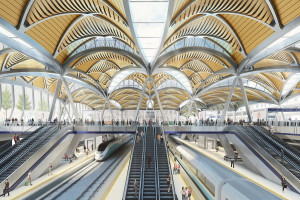Last year saw HS2, the hotly anticipated high speed rail network linking the north and south, receive Royal Assent. After three years of intense Parliamentary scrutiny, HS2 has been rubber stamped and delivery of the railway is now a priority.
HS2 is a monumental infrastructure undertaking. The first phase, from London to Birmingham, will not be operational until 2026, with the entire route expected to be delivered in 2033. However, the economic benefits are clear, and not just for business: HS2 Ltd has launched a raft of community funding opportunities alongside the development. Designed to engage local communities in the project, the funds will help integrate the railway into the landscape of Britain.
With Royal Assent granted, the hard work begins, and 2018 is being heralded as the ‘Year of Design’ by HS2’s developers.
UK Construction Media spoke exclusively to Kate Hall, Design Director at HS2 Ltd, about the plans and how development of Britain’s largest infrastructure project is getting under way. Below is an extract from the interview, to read the full piece, please download our HS2 special here.
UKCO: This year is being heralded as the ‘Year of Design’ for HS2; can you tell me more about why that is?
Kate: Well, this is the year that all the major design gets under way. The major contractors Joint Ventures and designers are on board and now we have to deliver. There are quite a lot of things going on as part of the project, as well as the actual railway. For instance, there is a massive infrastructure undertaking in terms of construction that goes along with the main railway project.
I’ve been at HS2 Ltd for the last three years. My role is to champion design. I’ve been working on creating written standards, specifications and design guidance for the project. What I’m really proud of on this project is that we’ve written a Design Vision. It’s a simple document, we’ve said that there are three key elements to this vision: people, place, and time. We are designing for people, for everyone to enjoy and benefit from HS2.

Curzon Street Station
UKCO: Can you tell me more about the design principles that are being applied to HS2?
K: Under each element are key points:
People: Design for our diverse need; engage communities in the project; inspire excellence and creative talent.
Place: Designing a sense of place; designing spaces and places that support real quality of life; celebrating the local within a coherent national narrative.
It’s not just about branding HS2 and its construction infrastructure and plonking it in the countryside, it’s about making it really right for the location. We also want to demonstrate our commitment to the natural world, so things like environmental standards and what we’re doing to push the circular economy are important. I think these areas are really ground breaking.
And the last element is:
Time: Standing the test of time, adapting to future generations. Really thinking about that. Placing a premium on a person’s time as a customer; and also making the most of time in design, which I am also very passionate about.
This design vision gives us the whys of wanting to design differently, and build something different on the project, and what we are setting out to achieve.
The other commitment that we have delivered is a design handbook, which gives us illustrations of how we are doing things differently and trying to think about things differently.
UKCO: And how are you achieving that?
K: Firstly, we have an independent design panel on the project, now that’s not unusual, but what we have done is set up this panel right at the start of the project, from inception really.

© HS2/Grimshaw
Now this is gaining quite a lot of interest in the civil engineering sphere. While it is quite common to set up some sort of independent design review panel for major infrastructure projects, this is usually done quite far on in the process.
What we have done is looked at other major infrastructure projects, and thought about what are the best lessons we can learn from them. In any project, the later you change the design, the more expensive it is, the more disruptive it is to the project, and the less likely it’s going to happen. So if you’re going to take independent advice, then set it up really early. Which is what we did, before we even had detailed design, while we are writing the strategies, and standards, and specifications, before we’d even procured contracts!
UKCO: Can you tell me a bit more about the ‘Year of Design’?
K: We are saying it’s the ‘Year of Design’. All the main works contractors for Phase 1 were appointed last summer, we are now six months in to an 18-month stage 1 design period. At the end, by Feb 2019, they will proceed to stage 2, and there will be detailed design. So, this is the year that everybody is designing Phase I of HS2. This year is so instrumental and influential for the future of our built environment in our towns, cities and the countryside, perhaps for the next 150 years, which is why I’m so passionate about 2018, and why the team is so excited to say that it IS the year of design.
UKCO: As the infrastructure is going be part of our landscape for such a long time, you must be using a variety of advanced technologies so it is able to stand the test of time.
K: Part of this goes back to our design vision, in terms of a sense of place and sense of time, in particular, the personal time of customers. What we have done is create an augmented reality simulation, where we’ve taken the whole route of the actual journey. So, if you were sitting on the train, what would you see out of the window?
UKCO: So, using new technology is a big part of the project?
K: Yes, a huge part. Here we started with using augmented reality (AR) as part of a landscape study. If we do special scenes or planting, or even have some strategic artwork, we would use new technology to consider where to put it. We are also looking at creating landmarks, – which we know offer passengers valuable visual clues along their journey, can enhance communities and even become visitor attractions in their own right.
We’ve had such a fantastic response, using this technology, that we’ve expanded it. The AR experience we’ve developed allows you to arrive on the pavement at Euston, walk through the station, go down onto the platforms, walk onto the train, and it takes you off on the HS2 route. As you glance out of the window, you go through tunnels, and we see the impact on the customer experience.

UKCO: This technology is being used to give you some really cutting-edge design experience, then?
K: Investing in the AR has allowed us to really think about the design of the infrastructure that we are building. Tools like this allow us to bring all those facets together and look at the details, allowing us to realise that if we take a slightly different angle to an approach it becomes a much more pleasant experience for the passenger and community.
UKCO: You said it is the Year of Design and it seems to have evolved from this basic synchronicity with the launch of AR & VR and the leaps forward in technology, that you can really start to design a project right from the very beginnings of an idea, rather than going back and having people complaining this is wrong, or having to retrofit things. To actually be able to get it right, from the very start of a project, sounds like it will be very transformative for the construction and engineering industry.
K: Yes. HS2 really is a once in a lifetime opportunity for us, and for us to improve the things we do. It’s not an upgrade or extension, it’s an entirely new project, and a huge responsibility for us. I think the design legacy that we leave absolutely has to be of the highest quality, because of the impact and the length of time it will be there. That is why we’ve spent a lot of time writing the vision and strategy and working with the design team to use new tools, and to push technology.
UKCO: The way you describe it, it appears that HS2 will not just be leaving a legacy of a massive infrastructure project that you are leaving, but a legacy of how to design projects, and how to engineer for the future, rather than the traditional approach construction and engineering typically has. You have been given the opportunity to do it differently now, and do it right from the beginning, exploring different designs and technologies, and the way you build.
K: That’s right. How do you design in flexibility? Stations won’t be the same in the future as they are now, so how do you design in that flexibility, so your building isn’t redundant in 80 years’ time? It’s really great challenge for design and a fantastic creative opportunity.
It’s a really exciting year for stage I, because we are seeing a lot of what we’ve done come to fruition and become visible and tangible.

Image by Hayes Davidson / Knight Architects
UKCO: You said that 2018 is the Year of Design, I’m sure there are some exciting announcements to come out around that?
K: January saw us announcing the designers of the stations. We are about to start our rail systems procurement, another part of our design draft, and procurement of that, and we are selecting our master development partners for around Euston and Old Oak Common stations. In the spring, we will be inviting our suppliers to bid for the rolling stock. We have done a lot of work on design challenges for this, and making sure the rolling stock meets our aspirations as set out in the design vision.
So, the HS2 design process is really taking a look into the future and building the future of design.
Read the full interview here. First appeared April 2018.
If you are interested in finding out more about key infrastructure trends today, you may wish to attend the flagship infrastructure exhibition at the NEC in April 2019 : UKIS 2019
Click here for more information on how to register or exhibit at the UK Infrastructure Show 2019.
If you would like to read more articles like this then please click here.
If you would like to read more articles like this then please click here.
The post Designing the future of infrastructure appeared first on UK Construction Online.




